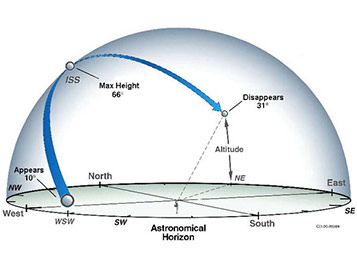See the International Space Station! As the third brightest object in the sky the space station is easy to see if you know when to look up.
NASA’s Spot The Station service gives you a list of upcoming sighting opportunities for thousands of locations worldwide, and will let you sign up to receive notices of opportunities in your email inbox or cell phone. The space station looks like a fast-moving plane in the sky, but it is dozens of times higher than any airplane and traveling thousands of miles an hour faster. It is bright enough that it can even be seen from the middle of a city! To learn more about the space station, its international crew, and how they live and working in space.
How to see NASA station with our naked eyes...
Time is when the sighting opportunity will begin in your local time zone. All sightings will occur within a few hours before or after sunrise or sunset. This is the optimum viewing period as the sun reflects off the space station and contrasts against the darker sky.
Visible is the maximum time period the space station is visible before crossing back below the horizon.
Max Height is measured in degrees (also known as elevation). It represents the height of the space station from the horizon in the night sky. The horizon is at zero degrees, and directly overhead is ninety degrees. If you hold your fist at arm’s length and place your fist resting on the horizon, the top will be about 10 degrees.
Appears is the location in the sky where the station will be visible first. This value, like maximum height, also is measured in degrees from the horizon. The letters represent compass directions -- N is north, WNW is west by northwest, and so on.
Disappears represents where in the night sky the International Space Station will leave your field of view.

Important: The International Space Station orbits with an inclination of 51.6 degrees. This means that, as it orbits, the farthest north and south of the Equator it will ever go is 51.6 degrees latitude. If you live north or south of 51.6 degrees, the ISS will never go directly over your head- this includes places like Alaska. Spot the Station may not properly inform you of all visible space station passes in these locations. Spot The Station’s location pages will give you a list of all possible space station sightings for your location.
To see the time zone for your region - Click here
